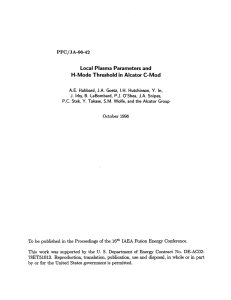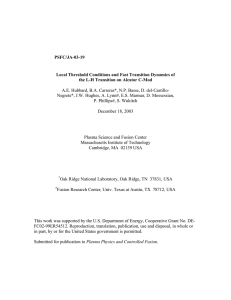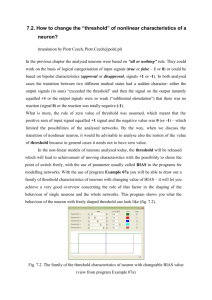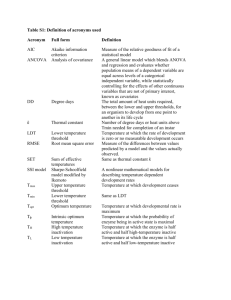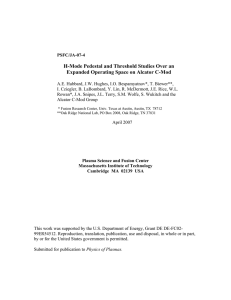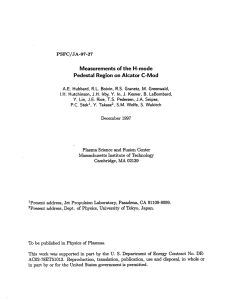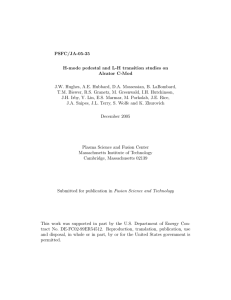Local Variables Affecting H-Mode Threshold on Alcator C-Mod
advertisement
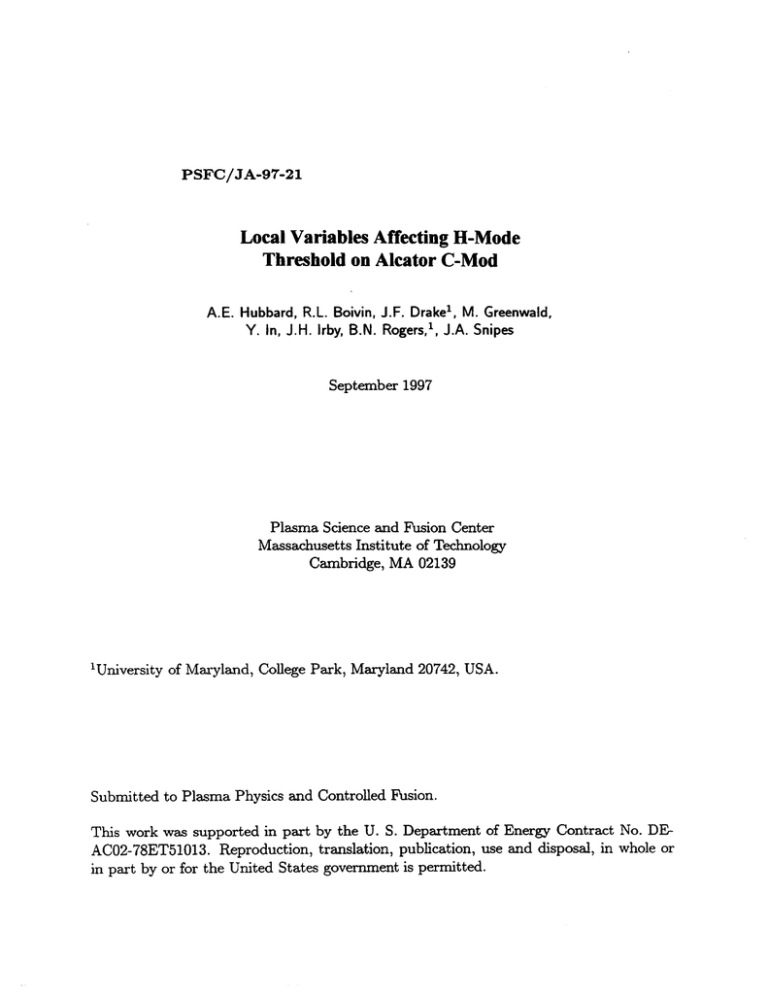
PSFC/JA-97-21 Local Variables Affecting H-Mode Threshold on Alcator C-Mod A.E. Hubbard, R.L. Boivin, J.F. Drake', M. Greenwald, Y. In, J.H. Irby, B.N. Rogers,', J.A. Snipes September 1997 Plasma Science and Fusion Center Massachusetts Institute of Technology Cambridge, MA 02139 'University of Maryland, College Park, Maryland 20742, USA. Submitted to Plasma Physics and Controlled Fusion. This work was supported in part by the U. S. Department of Energy Contract No. DEAC02-78ET51013. Reproduction, translation, publication, use and disposal, in whole or in part by or for the United States government is permitted. Local Variables Affecting H-mode Threshold on Alcator C-Mod* A E Hubbard, R L Boivin, J F Draket, M Greenwald, Y In, J H Irby, B N Rogerst and J A Snipes *Supported by U.S. D.O.E. Contract No. DE-AC02-78ET51013. MIT Plasma Science and Fusion Center, Cambridge, MA USA tUniversity of Maryland, College Park, Maryland 20742, USA Abstract. An edge temperature threshold for the L-H transition is found on the Alcator C-Mod tokamak. The critical temperature depends weakly on density and increases with BT and with unfavourable drift direction. T, at the H-L transition can be equal to or greater than the L-H threshold. Magnetic fluctuations are observed at some H-L transitions. Measured parameters are compared with H-mode theories, including non-linear drift ballooning code simulations. Submitted to Plasma Phys. Control. Fusion 1 2 A E Hubbard etal 1. Introduction Recent exploration of the H-mode threshold on Alcator C-Mod, at fields up to 8 T, has concentrated on the characterization of local threshold conditions. In particular, we have been studying electron density and temperature in the region just inside the separatrix, where the H-mode pedestals form. As reported in [1], the global power threshold on C-Mod is relatively low, but as on other machines and indeed in the multimachine ITER database[2] it shows considerable scatter. Coating the molybdenum surfaces of the machine with boron has significantly improved the H-mode confinement and duration by reducing radiative losses. A new 'Enhanced D-alpha' regime which has good confinement in steady state is often observed, generally following an ELM-free period [3]. At the last H-mode workshop, it was noted that a critical edge temperature is associated with the L-H transition [4]. Local conditions at the transition have now been documented much more fully. The edge diagnostic set is described in the following section. Parameters at L-H and H-L thresholds are then presented and the possible role of neutrals discussed. Connection is made with recent theoretical modelling. 2. Diagnostics The primary electron temperature diagnostic used is a 9-channel, absolutely calibrated ECE grating polychromator, which has - 2 cm channel spacing and 9 mm resolution. T profiles in L-mode are typically linear in the outer half of the plasma, so that interpolation onto a desired location, usually the 95% poloidal flux surface, is straightforward. We do not yet measure edge T profiles, however the electron-ion equilibration time at the edge is a few milliseconds, so it is reasonable to assume Ti Te. The main density profile diagnostic is an interferometer with 10 vertical chords[5]. Since the chords are located well inside the separatrix, assumptions must be made about the edge density in the Abel inversion process. A parametrization based on probe measurements of the SOL is used. More detailed information on the edge density can be obtained from reflectometry[6]. However, these profiles were not routinely measured during many of the studies reported here. Edge densities are therefore derived from the interferometer and tend to reflect the average density in the discharge. Higher resolution (1-2 mm) diagnostics of x-ray and uv-xuv emission have also recently begun measuring the edge region of C-Mod and are useful in studying the pedestal width and evolution[7]. 3. Local Conditions at L-H and H-L Transition The clearest demonstration of a local threshold condition for the L-H transition on C-Mod comes from a dedicated density and power scan in which ICRF power (the only auxiliary heating method) was stepped up in small increments to find the minimum Local H-mode Threshold on C-Mod 3 threshold power. This was repeated for fixed magnetic configuration (I, = 0.8MA and BT = 5.3T) at different densities. Figure 1 shows that the threshold power varies non-linearly, increasing both at higher densities and near the low density limit, and is not well described by any simple scaling. The edge electron temperature, in contrast, is always close to 120 eV at the L-H transition, independent of density. This strongly suggests a necessary condition in T or a closely related parameter (eg Ti, VT) for obtaining H-mode. We have also monitored local conditions prior to L-H or H-L transitions for many other non-dedicated H-mode discharges in a broad range of plasma parameters. Figure 2 shows the edge parameter space for plasmas with BT = 8 T. The edge temperature is again in a fairly narrow range (200-250 eV) for most of the L-H transitions, and is clearly higher than at 5.3 T. A few discharges at the lowest densities show somewhat higher threshold temperatures. A similar tendency is seen in the complete 5.3 T dataset. Statistical regressions give T,,.i cC B 6±0.15 ;0.57O.1-O.17±0.2. The dependence, if any, on I, is thus within the scatter of the data and will require more controlled scans. Perhaps not surprisingly, the complete dataset, with over 130 L-H transitions, gives a wider scatter in threshold T than the controlled scan. We find that VT shows somewhat less variation. It is not clear whether this is because it is a more physically significant variable or simply that it is less sensitive to small uncertainties (few mm) in the relative position of the ECE channels and plasma flux surfaces. Furthermore, most of the discharges with unusually high VTe at threshold have relatively low midplane and divertor neutral pressure, as shown in Figure 3. If one excludes cases with Po,id < 0.01 Pa, neither T nor VT at the transition show a significant density dependence. Some discharges with particularly high neutral pressure (> 0.05Pa), for example due to changes in wall interactions, have H-mode power thresholds which are 50% higher than in our best cases, while edge T at the transition is not increased. This suggests that neutrals can in some cases cool the edge significantly, and may explain some of the scatter in the global power threshold. Interpreting the effects of neutrals on the threshold is complicated by neutral penetration. The relevant variables may be neutral density and/or scale length immediately inside the separatrix. As shown by Owen etal for DIII-D plasmas, these do not correlate directly with external pressures[8]. Efforts are underway to complete a 2-D analysis of neutrals in collaboration with the group at ORNL. A few experiments were carried out with the field and current direction reversed, giving the ion VB drift direction away from the active divertor rather than towards it. As observed on other tokamaks, roughly twice as much input power was required to obtain H-mode in this case. We found that the edge threshold temperature is also doubled. This means that H-mode theories must account for a local threshold which varies with different drift directions, and may imply that flows in the SOL, which are known to depend on drift direction[9], are playing a role. Boronization, while reducing on average the power required to enter H-mode, does 4 A E Hubbard etal not significantly change the L-H threshold temperature. It has, however, changed the H-mode evolution and the H-L transition behaviour. Without boronization the initial edge temperature pedestal is generally eroded in < 100 ms due to higher radiation, leading either to type III ELMs or to an H-L transition. In this case the H-L transition temperature is essentially the same as the L-H threshold[4], showing little or no hysteresis. With boronization, some ELM-free H-mode phases are still terminated by an erosion of the edge pedestal, though after a much longer duration. Many EDA H-modes persist in nearly steady state until the end of the RF pulse. At some H-L transitions the T pedestal drops within a few ins , simultaneous with the rise in D, at H-L transition. The temperature at such rapid back-transitions shows large scatter, as reflected in Figure 2, and is often greater than at the L-H threshold. Analysis of fast magnetic fluctuations shows that in some rapid transitions a burst of fluctuations accompanies the pedestal crash, suggesting a role of MHD instabilities. Magnetic precursors at > 100 kHz have been seen 100 ps before D, emission starts to rise, followed by a larger amplitude, lower frequency burst. The cause of the MHD activity is still being investigated. In determining the local conditions for HL transitions it is clearly important, though not always easy, to distinguish between those which are caused by lack of power or erosion of the edge pedestal and those which may be due to instability of the pedestal. 4. Comparison with Theory The availability of local parameters at the H-mode transition, on C-Mod as well as on other machines [10-13], makes possible much more direct comparisions with theory than could be done on the basis of global power thresholds. All current theories involve edge parameters, either in the SOL or the pedestal region. Probably the most prevalent idea is that E x B velocity shear leads to turbulence suppression [14,15]. The existence of a threshold in VT, which is closely related to VP/n, is certainly consistent with such a picture. However, the theories as presently developed do not lead to easily testable predictions for an H-mode threshold. Edge toroidal and poloidal rotations, for which we do not yet have data on C-Mod, can be important variables in this model. The addition of a diagnostic neutral beam will enable us to measure rotations as well as T(R) and j(R) in the near future. In a different approach, 3-D numerical simulations of drift-ballooning turbulence near the plasma edge have been carried out [16,17]. The transport in these simulations depends critically on two dimensionless parameters: the ideal MHD ballooning parameter a = -Rq 2di3/dr, and an ion diamagnetic parameter adi = vdioto/Lo, where Vdio = psc8 /Lpi is the equilibrium ion diamagnetic velocity, to is the ideal ballooning time and Lo is a characteristic turbulence scale length. These variables are as defined in [16], except that we have used the shorter ion pressure scale length Lp, in place of L,. The simulations indicate that a transport barrier spontaneously forms due to self-generated, sheared poloidal flows when these parameters both exceed certain Local H-mode Threshold on C-Mod order-unity thresholds: a accrit, adi ad,.it, where, for the case of Ti ~ Te, 5 1, and 77i 1, aOcit - 0.5 and adicrit ~ 0.75. Figure 4 shows a plot of a and adi values, computed at the 'b = 0.95 surface, for the 8 T L-mode points from Figure 2. The L-H transitions, represented by solid triangles, do exhibit thresholds in these parameters which are close to the critical values a&,.it and adi,c,.it predicted by the simulations. L-H transitions at 5.3 T, while displaying greater scatter as in the raw data, overlap the 8 T points in this dimensionless space despite having quite different global and local threshold parameters. It should be noted that the scale lengths Lpi and L, vary in space and have significant experimental uncertainties. Inside the separatrix 77i > 1 for C-Mod, unlike in the simulations to date. We thus find the level of agreement of predicted and measured thresholds very encouraging, and will pursue further comparisons. There is not as yet a single H-mode theory which can be definitively validated by local threshold parameters. However, much progress is being made by such comparisons on several tokamaks. It is for example evident that theories requiring a threshold temperature which increases with density (e.g. constant collisionality) are inconsistent with our measured data. A key issue is to define at what radial point comparisons should be made; with steep gradients a few mm can change any threshold criterion significantly. On a single device, parameters such as T, VT, VP/ne and f are inevitably strongly correlated, making it difficult to distinguish between possible thresholds. We hope to make further progress by comparing data between machines. Joint experiments which attempt to match dimensionless variables in the plasma edge region are planned with ASDEX-UG, DIII-D and JET. References [1] Hubbard A E etal 1996 Proc. 16th IAEA Fusion Energy Conference, (Montreal) IAEA-CN64/AP2-1 1),to be published [4] Ryter F, H-mode Database Working Group, 1996 Nucl. Fusion 36 1217 [3] Takase Y, etal 1997 Phys. Plasmas4(5) 1647 [4] Snipes J A etal 1996 Plasma Phys. Control. Fusion 38 1127 [5] Irby J H etal 1988 Rev. Sci. Instrum. 59(8) 1568 [6] Stek P C, Reflectometry Measurements on Alcator C-Mod PhD thesis, MIT 1997 [7] Snipes J A etal 1997 this conference [8] Owen L W etal 1997 this conference [9] Hutchinson I H etal 1995 Plasma Phys. Control. Fusion 37 1389 [10] Carlstrom T N and Groebner R J 1996 Phys. Plasmas 3(5) 1867 [11] Fukuda etal 1996 Proc. 16th IAEA Fusion Energy Conference, (Montreal) IAEA-CN-64/AP2-9, to be published [12] Zohm H etal 1996 Proc. 16th IAEA Fusion Energy Conference, (Montreal) IAEA-CN-64/A5-1, to be published [13] Righi E etal 1997 Proc. 24th EPS Conf. on ControlledFusion and Plasma Physics (Berchtesgaden) to be published [14] Burrell K H 1997 Phys. Plasmas 4(5) 1499 [15] Diamond P H etal 1994 Phys. Rev. Letters 72 2565 [16] Rogers B N and Drake J F 1997 Phys. Rev. Letters 79 229 [17] Rogers B N and Drake J F, 1997 Sherwood Conference (Madison, WI), Invited talk 1B04 6 A E Hubbard etal Figure captions CL 2 0 0 A 1A OA 0 0 0 a- 0. to 0.2 -3 [-L-mode P=0.02 nBS --- 2 L -H mode trans. M vi 0 0 0 A 0O'q 0 o 0 'I0. 0. 0 0.0 0.5 1.0 1.5 N (10 20 2.0 2.5 3.0 3 m- ) Figure 1. Global (top) and local (bottom) threshold conditions for H-mode during a density and power scan with BT = 5.3T and I, = 800kA, showing an edge T, threshold. 0. 6 [ 0. 4 L-mode 0 A L-H transition v H-L transition 0 H-mode (ali types) 0 0 0 V 0 0 0 0. 2 0.0 0.0 0.5 1.0 n,, 'if =0.95 1.5 2.0 2.5 (1020 m- 3) Figure 2. Temperature and density at V) = 0.95 for L-modes, H-modes and transitions in discharges with BT = 8 T and 1P = 1.0-1.25 MA. A higher L-H threshold is seen. T, varies at H-L transitions, but is always > T(-H). Local H-mode Threshold on C-Mod 7 20 E 15- to 10. ~AA 1 0 A *4A ,AA If A~ Ajjt A A A 5- A A 0 0.00 0.02 0.04 0.06 Midplane Pressure (Pa) 0.08 Figure 3. Edge T, gradient at the IH transition vs midplane neutral pressure P, for a set of discharges with BT = 5.3 T, I, = 0.8-1.2 MA. The threshold has most scatter at low P0 . 0.6 n A L-mode L-H transitions E 0.4 0 C 0 AO A 0.2 02 0.0 k 0. 0 0.2 0.4 0.6 0.8 Ion Diamagnetic Parameter adi 1.0 Figure 4. Dimensionless ballooning parameter a vs the ion diamagnetic parameter ad; for L mode time slices with BT= 8 T. Solid triangles indicate I-H transitions, and are near predicted critical values.
